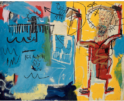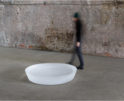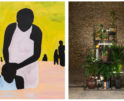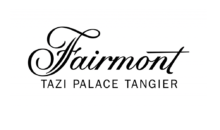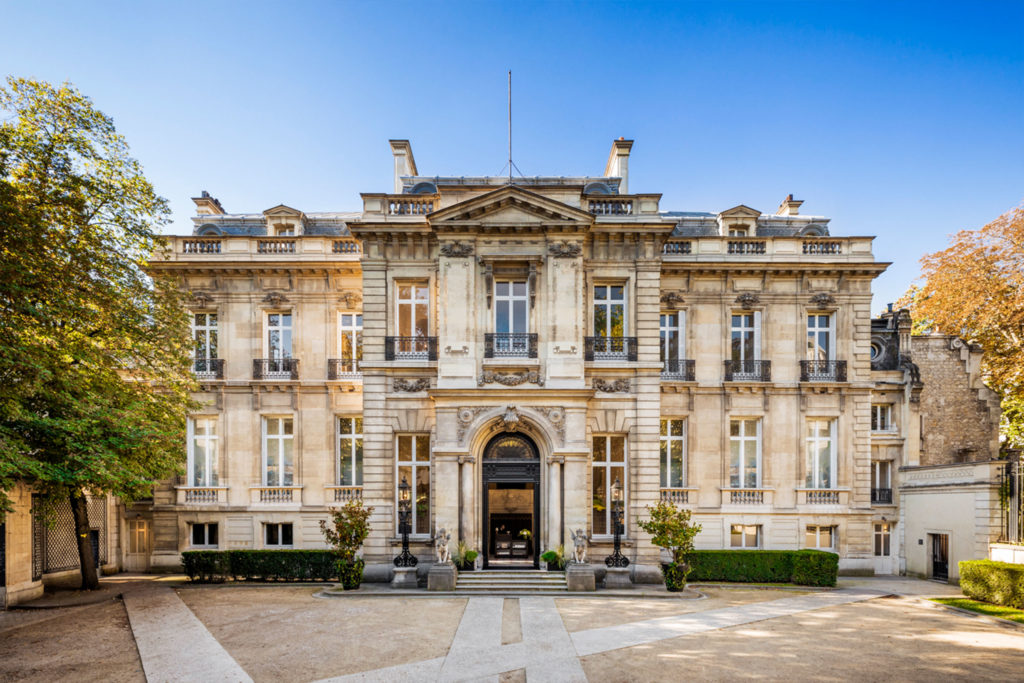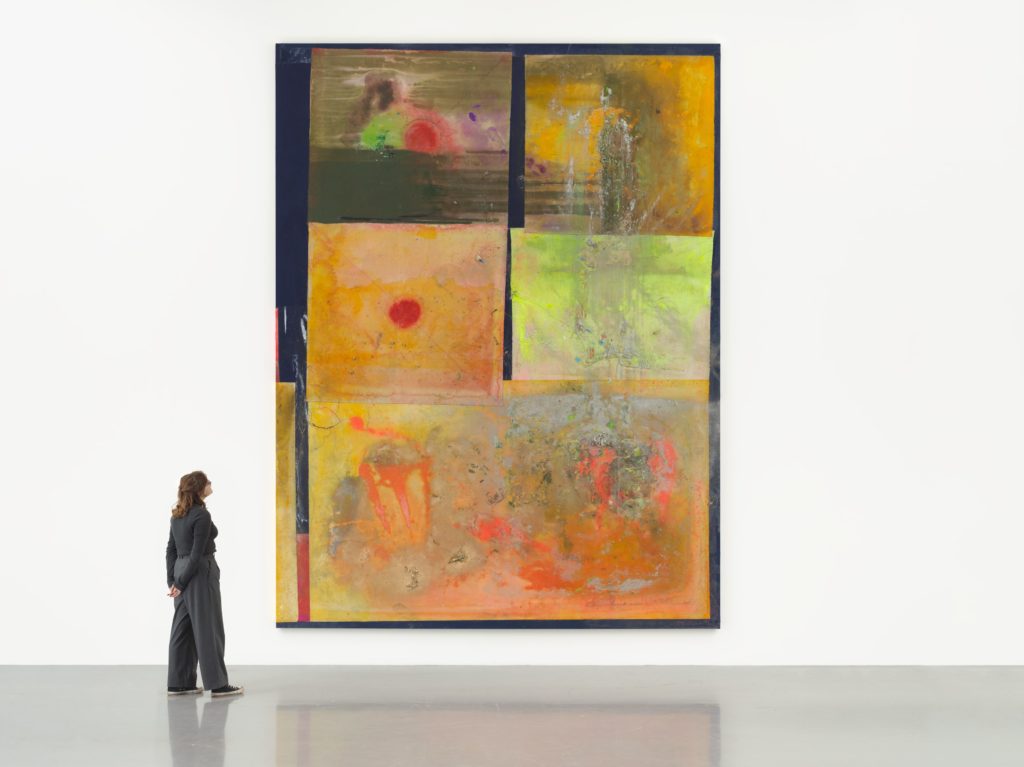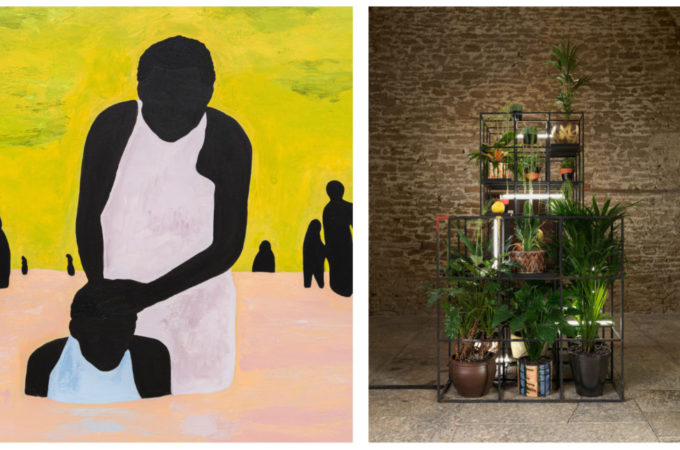
Hauser & Wirth New York – The Flesh of the Earth. Curated by Enuma Okoro
New York…
Hauser & Wirth New York is pleased to present ‘The Flesh of the Earth,’ a multidisciplinary exhibition curated by Nigerian-American writer and critic Enuma Okoro. Through work by artists Olafur Eliasson, Adama Delphine Fawundu, Jenny Holzer, Rashid Johnson, Haley Mellin, Cassi Namoda, Lorna Simpson, Kiki Smith, Pamela Phatsimo Sunstrum and Billie Zangewa, the presentation, in the words of Okoro, ‘encourages us all to consider ways of decentering ourselves from the prevalent anthropocentric narrative, to reimagine a more intimate relationship with the earth and to renew our connection with the life-force energy that surges through all of creation, both human and more-than-human. Our human bodies—one of a diversity of created bodies of the natural world—are the primary language with which we dialogue with the earth. By acknowledging that these varied bodies are always in relationship we reawaken our awareness of the quality of those relationships, considering where we may falter or harm, and also deepen our appreciation and recognition of our interdependence with the more-than-human world.’
The exhibition will also include the poetry of acclaimed author Ama Codjoe, who draws both poignant and striking images with her words, articulating the kind of sensuous and imaginative self-reflection that can stir us to rekindle a necessary intimacy with the more-than-human—again, emphasizing the body as the primary vehicle through which to achieve this.
The interrelationship between the different bodies of the natural world that Codje conjures recurs creatively and sometimes delicately and subtly throughout many of the works in the exhibition. Olafur Eliasson’s sculptural work ‘Now, here, nowhere’ (2023) lines up layered panels of colored glass along a length of found driftwood from Iceland. The gold, red-orange and blue-green circles and ellipsis, and the naturally weathered wood all evoke reconsiderations of time and temporality, including how bodies of water envelop and move intimately over other natural organic matter. And yet also in their likeness to suns and moons, elements of the work seem to lend to contemplation on the effects of circadian rhythms, and the solar and lunar cycles on human and non-human animal behavior and physiology. Other work gestures towards the human body as a link, like Adama Delphine Fawundu’s photograph ‘Ngewo Whispers’ (2022) from a series in which the artist occupies ghostly sites that bore witness to events of the African diaspora, in this case Savannah GA. In Fawundu’s photograph, she captures herself dressed in a bright blue dress and wearing cowries in her hair amidst a verdant setting. The scene situates the artist’s body as a bridge between the human and more-than-human worlds, threading a connective strand of exchange between the generative, energetically active space of nature and the material structures of history.
Water, a potent symbol for life, death and rejuvenation, also plays a central role in ‘The Flesh of the Earth.’ New paintings by Cassi Namoda depict richly hued, abstracted seascapes that reference the African philosophical and religious theological teachings of Kenyan-born philosopher John Mbiti. In Namoda’s ‘Maternal Possession in Lago Regorria’ (2023) she evokes the Christian ritual of baptism in which the spirit is believed to invade the body and stimulate new life—yet the spiritual experience of rebirth is common to many traditions. The anonymous, nameless figures appear vulnerable as they submit to the powerful, primordial expanse of the sea. There are ways in which our broken relationship with more-than-human nature must also find new life. Namoda’s paintings simultaneously remind us of our natural beginnings in wombs of water, and our utter reliance on water to survive.
‘The Flesh of the Earth’ implores us to renew our connection to the fuller natural world by highlighting our estrangement from it in the first place. At the heart of the exhibition is Rashid Johnson’s living work, ‘Untitled Stranger’ (2017), which requires the committed relationship from humans to care for it and ensure its sustained life. The immersive sculptural installation invites viewers to circle the work and study the various symbolic objects placed within its stacked, architectural grids—live plants in ceramic pots made by Johnson, carved blocks of shea butter, parachutes and a selection of books. These objects carry deep meaning for the artist; from essence extracted from the shea trees found across central Africa to titles like Albert Camus’ ‘The Stranger’ and ‘The Crisis of the Negro Intellectual’ by Harold Cruse, every item points to themes of alienation and escape, and the wistful quest to reconnect with a feeling of belonging and of familiarity.
Okoro says, ‘The remedy to estrangement is an intentional and caring rekindling of relationship. We must return to thinking of the earth as also imbued with life-force energy as we are, with an aliveness whose health and engagement is essential to our collective well-being. The more-than-human world holds patterns of intimacy that we can learn from and participate in, but which require us to acknowledge and to draw closer to the rest of nature’s own inherent eroticism. It is only in recognizing and honoring the aliveness and sacrality of this world that we can reimagine a new and sustainable kinship.’ Through their sensorial formal qualities and symbolic resonance, the works on view here offer glimpses of what could be beyond our quotidian humanmade realm, urging us to recognize our collective dislocation and distance from the more-than-human, and to open ourselves to a renewed relationship with the rest of the natural world.
In Okoro’s words, ‘We are unwholly ourselves when we mark stark boundaries between our bodies and that of other non-human bodies of nature. To speak of nature as something that exists apart from us or something merely ‘outside’ is to deny our own creatureliness and our humus-ness. We are part of the environment. We too are of the soil and the elements. Born from the water of the womb, at death we recycle back to the humus of the earth, where living microbes already exist in thriving interrelated communities, and the bodies of plants and animals also return to provide nourishment. There is so much transformative and necessary relational engagement between our beginnings and endings to which we have to return, and in some instances heal.’
On Saturday 3 February at 4pm, Hauser & Wirth will host a public program at its 18th Street gallery featuring readings of Ama Codjoe’s poetry by poet Maya Marshall, prose readings by Enuma Okoro and a screening of Adama Delphine Fawundu’s film ‘Cosmic Echoes’ (2023) accompanied by a special musical performance by the artist’s son, Che Buford. More details about the event, as well as registration information, will be available at hauserwirth.com.
About the curator
Enuma Okoro is a Nigerian-American author, journalist, theologian, lecturer, and arts and culture critic. She is a weekly columnist for the Financial Times newspaper. Her weekend column, ‘The Art of Life,’ reflects her broader research and writing interests: how the intersection of art, philosophy, spirituality, ecology and culture can speak to the human condition and interrogate how we live. Underlying this interrogation is a deeper interest in knowledge systems, from ethno-epistemology to (black feminist, BIPOC, diasporan) critical theory, and the power of narrative and story. She writes, lectures, curates and hosts public conversations with the grounding premise that stories, through their varying mediums, are how we challenge old or false narratives, free our imaginations and tell new and expanded truths that shift perceptions and instigate change. And she believes that stories are everywhere. Even the trees and the rivers and the animals hold them.
Recommended
-
Galerie Mitterrand Wins ‘Best Historic Piece’ Award at DESIGN MIAMI Paris 2024October 28th, 2024
-
L’ANGE GÉOGRAPHE BY JEAN-CHARLES DE CASTELBAJAC FOR THE SOCIÉTÉ DE GÉOGRAPHIEJune 18th, 2024
-
Hauser & Wirth New York – Roni Horn + SpringMarch 18th, 2024
-
Hauser & Wirth New York – The Flesh of the Earth. Curated by Enuma OkoroJanuary 16th, 2024






